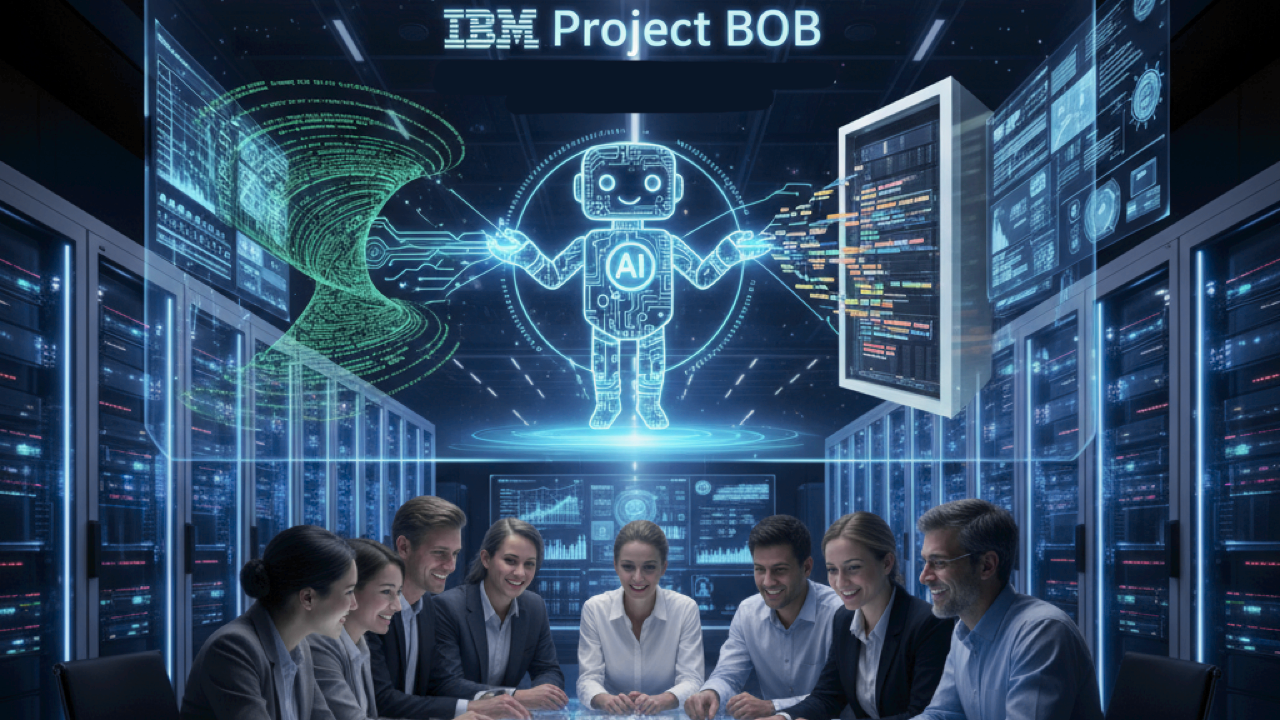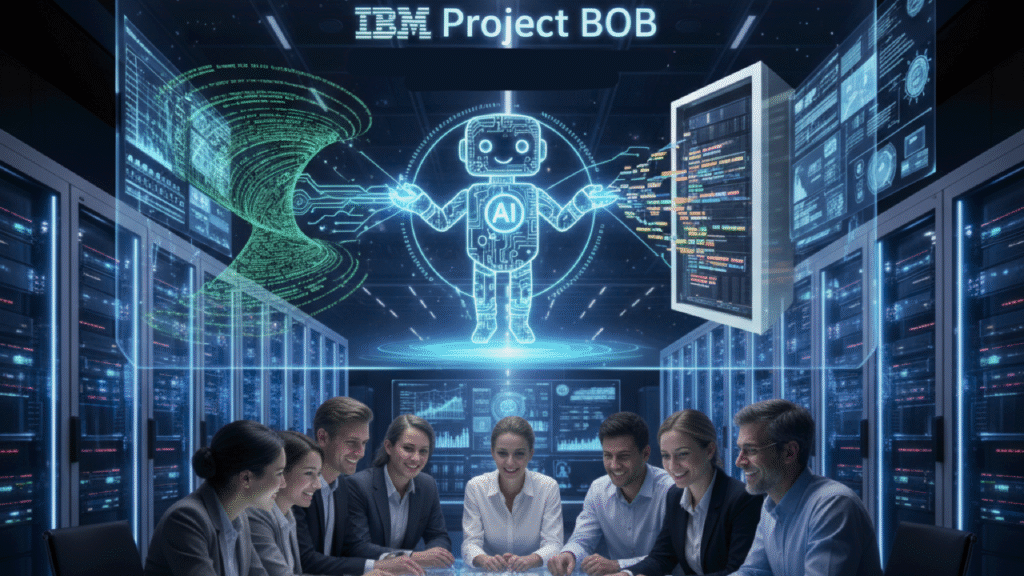
For many enterprises, there continue to be barriers to fully adopting and benefiting from agentic AI.
IBM is betting the blocker isn't building AI agents but governing them in production.
At its TechXchange 2025 conference today, IBM unveiled a series of capabilities designed to bridge the gap: Project Bob, an AI-first IDE that orchestrates multiple LLMs to automate application modernization; AgentOps for real-time agent governance; and the first integration of open-source Langflow into watsonx Orchestrate, IBM's platform for deploying and managing AI agents. IBM's announcements represent a three-pronged strategy to address interconnected enterprise AI challenges: modernizing legacy code, governing AI agents in production and bridging the prototype-to-production gap..
The company claims 6,000 internal developers within IBM have used Project Bob, achieving an average productivity gain of 45% and a 22-43% increase in code commits .
Project Bob isn't another vibe coder, it's an enterprise modernization tool
There is no shortage of AI-powered coding tools in the market today, including tools like GitHub Copilot and vibe coding tools such as Replit, Cursor, Bolt and Lovable.
"Project Bob takes a fundamentally different approach from tools like GitHub Copilot or Cursor," Bruno Aziza, IBM's Vice President of Data, AI and Analytics Strategy told VentureBeat.
Aziza said that Project Bob is enterprise-focused and maintains full-repository context across editing sessions. It automates complex tasks like Java 8 to more modern version of Java and framework upgrades from Struts or JSF to React, Angular or Liberty.
The architecture orchestrates between Anthropic's Claude, Mistral, Meta's Llama and IBM's recently released Granite 4 models through a data-driven model selection approach. The system routes tasks to whichever LLM is best suited, balancing accuracy, latency and cost in real time.
"It understands the entire repository, development intent and security standards, enabling developers to design, debug, refactor and modernize code without breaking flow,” he said.
Among 6,000 early adopters within IBM, 95% used Bob for task completion rather than code generation. The tool integrates DevSecOps practices like vulnerability detection and compliance checks directly into the IDE.
"Bob goes beyond code assistance — it orchestrates intelligence across the entire software development lifecycle, helping teams ship secure, modern software faster," he said.
Project Bob benefits from new Anthropic partnership
Part of Project Bob is a new partnership between IBM and Anthropic
The two vendors announced a partnership to integrate Claude models directly into the watsonx portfolio, starting with Project Bob. The collaboration extends beyond model integration to include what IBM describes as a first-of-its-kind guide for enterprise AI agent deployment.
IBM and Anthropic co-created "A Guide to Architecting Secure Enterprise AI Agents with MCP Servers," focused on the Agent Development Lifecycle (ADLC). The ADLC framework provides a structured approach to designing, deploying and managing enterprise AI systems. MCP refers to Model Context Protocol, Anthropic's widely embraced open standard for connecting AI assistants to the systems and data they need to work with.
Making it easier to build enterprise-grade AI agents
In addition to Project Bob, IBM announced that it is extending its watsonx Orchestrate technology to integrate the open source Langflow visual agent builder. Langflow is an open-source technology that is led by DataStax, which itself was acquired by IBM in May of this year. The integration of Langflow is intended to address what Aziza calls the "prototype to production chasm."
"Today, there's no seamless path from open-source prototyping to enterprise-grade systems that are reliable, compliant and scalable," Aziza said. "Watsonx Orchestrate transforms Langflow-like agentic composition into an enterprise-grade orchestration platform by adding governance, security, scalability, compliance, and operational robustness — making it production-ready for mission-critical use.”
Aziza explained that the integration of Langflow with watsonx Orchestration brings critical capabilities on top of the open-source tool including:
Agent lifecycle framework: Provisioning, versioning, deployment and monitoring with multi-agent coordination and role-based access.
Integrated AI governance: Embedded watsonx.governance provides audit trails, explainability for agent decisions, bias and drift monitoring and policy enforcement. Langflow has no native governance controls.
Enterprise infrastructure: SaaS or on-premises hosting with data isolation, SSO/LDAP integration and fine-grained permissions. Langflow users must manage their own infrastructure and security.
No-code and pro-code options: Langflow is "low-code." IBM added a visual, no-code Agent Builder and a pro-code Agent Development Kit for seamless promotion from prototype to production.
Pre-built domain agents: Catalog of HR, IT and finance agents integrated with Workday, SAP and ServiceNow.
Production observability: Built-in dashboards, analytics and enterprise support SLAs with continuous performance monitoring.
AgentOps and Agentic Workflows: From building to governing
IBM is also introducing two new capabilities to watsonx Orchestrate that work in tandem with the Langflow integration: Agentic Workflows for standardized agent coordination and AgentOps for production governance.
Agentic Workflows addresses what Aziza calls the "brittle scripts" problem. Today developers build agents using custom scripts that break when scaled across enterprise environments. Agentic Workflows provides standardized, reusable flows that sequence multiple agents and tools consistently. This connects directly to the Langflow integration. While Langflow provides the visual interface for building individual agents, Agentic Workflows handles the orchestration layer, coordinating multiple agents and tools into repeatable enterprise processes.
AgentOps then provides the governance and observability for those running workflows. The new built-in observability layer provides real-time monitoring and policy-based controls across the full agent lifecycle.
The governance gap becomes concrete in enterprise scenarios. Without AgentOps, an HR onboarding agent might set up benefits and payroll but teams lack visibility into whether it's applying policies correctly until problems surface. With AgentOps, every action is monitored in real time, allowing anomalies to be flagged and corrected immediately.
What this means for enterprises
Technical debt is something that many organizations struggle with and it can represent a non-trivial barrier for organizations looking to get into agentic AI deployments.
Project Bob's value proposition is clearest for organizations with significant legacy Java codebases. The 45% productivity gains IBM measured internally suggest meaningful acceleration for Java 8 to more modern versions of Java and framework upgrades from Struts or JSF to modern architectures. However, these metrics come from IBM developers working on IBM systems. The critical unknown is whether the multi-model orchestration delivers the same results on customer codebases with different architectural patterns, technical debt profiles and team skill levels.
The Langflow integration addresses a genuine gap for teams already using open source agent frameworks. The challenge isn't building agents with tools like LangChain, LangGraph or n8n. It's adding the governance layer, lifecycle management, enterprise security controls and observability required for production deployment.
For enterprises looking to lead in AI adoption, IBM's announcements serve to reinforce the fact that governance infrastructure is now table stakes. You can build agents quickly with existing tools. Scaling them safely requires the lifecycle management, observability and policy controls.
Project Bob is now available in private tech preview with broader availability expected in the future. IBM is accepting access requests through its developer portal. Its AgentOps and agentic workflows integrations are now available in watsonx Orchestrate, while its Langflow integration is expected to be generally available at the end of this month.

